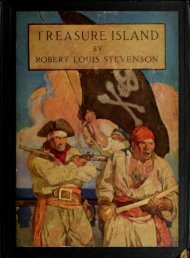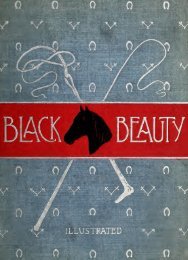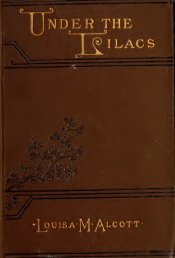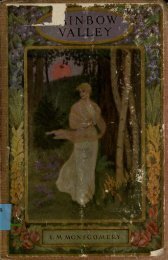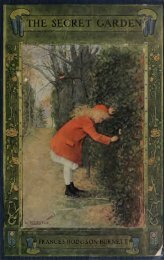- Page 2 and 3: 1 1iIi11oS- ^ete^IOS-ANCEIS^OF-CALI
- Page 5: j-
- Page 9 and 10: IUNCLE REMUSHIS SONGS AND HIS SAYIN
- Page 11 and 12: ?5IS01PEEFACE AND DEDICATIONTO THE
- Page 13: PREFACE AND DEDICATION.vyour hand a
- Page 16 and 17: viiiINTRODUCTION.of the Hon. Pompey
- Page 18 and 19: xINTRODUCTION.loose because the ter
- Page 22 and 23: xivINTRODUCTION.B'er Cooler answer;
- Page 24 and 25: noshilljin'terners'llw'enenendayout
- Page 27 and 28: CONTENTS.LEGENDS OF THE OLD PLANTAT
- Page 29: CONTENTS.xx iPAGEIII. Uncle Remus a
- Page 33: LEGENDS OF THE OLD PLANTATION.
- Page 36 and 37: '4 LEGENDS OF THE OLD PLANTATION.fa
- Page 38 and 39: 6 LEGENDS OF THE OLD PLANTATION."Bi
- Page 40 and 41: 8 LEGENDS OF THE OLD PLANTATION.twe
- Page 42: 10 LEGENDS OP THE OLD PLANTATION.se
- Page 45 and 46: WHY MR. POSSUM LOVES PEACE.look sor
- Page 47 and 48: WHY MR. POSSUM LOVES PEACE. 13wuz s
- Page 49 and 50: WHY MR. POSSUM LOVES PEACE. 15sampl
- Page 51 and 52: HOW MR. RABBIT WAS TOO SHARP FOR MR
- Page 53 and 54: HOW MR. RABBIT WAS TOO SHARP FOR MR
- Page 55 and 56: THE STORY OF THE DELUGE. 21same lik
- Page 57 and 58: THE STORY OF THE DELUGE. 23" Where
- Page 59 and 60: MR. RABBIT GROSSLY DECEIVES MR. FOX
- Page 61 and 62: sezee.MR. RABBIT GROSSLY DECEIVES M
- Page 63 and 64: MR. RABBIT GROSSLY DECEIVES MR. FOX
- Page 65 and 66: MR. FOX IS AGAIN VICTIMIZED. 31minu
- Page 67: "En den he tu'n loose, he did."
- Page 70 and 71:
34 LEGENDS OF THE OLD PLANTATION.te
- Page 72 and 73:
36 LEGENDS OF THE OLD PLANTATION."
- Page 74 and 75:
38 LEGENDS OF THE OLD PLANTATION."
- Page 76 and 77:
LEGENDS OF THE OLD PLANTATION." 'Yo
- Page 78 and 79:
LEGENDS OF THE OLD PLANTATION.ger'n
- Page 80 and 81:
LEGENDS OF THE OLD PLANTATION.uns m
- Page 82 and 83:
46 LEGENDS OF THE OLD PLANTATION.tr
- Page 84 and 85:
48 LEGENDS OF THE OLD PLANTATION.pr
- Page 86 and 87:
50 LEGENDS OF THE OLD PLANTATION.Ji
- Page 88 and 89:
52 LEGENDS OF THE OLD PLANTATION."
- Page 90 and 91:
54: LEGENDS OP THE OLD PLANTATION/f
- Page 92 and 93:
56 LEGENDS OP THE OLD PLANTATION."D
- Page 94 and 95:
58 LEGENDS OF THE OLD PLANTATION."
- Page 96 and 97:
60 LEGENDS OF THE OLD PLANTATION."
- Page 98 and 99:
62 LEGENDS OF THE OLD PLANTATION."
- Page 100 and 101:
64 LEGENDS OF THE OLD PLANTATION.st
- Page 102 and 103:
66 LEGENDS OF THE OLD PLANTATION.ev
- Page 104 and 105:
68 LEGENDS OF THE OLD PLANTATION."
- Page 107 and 108:
MR. POX AND THE DECEITFUL FROGS. 69
- Page 109 and 110:
MR. FOX AND THE DECEITFUL FROGS. 71
- Page 111 and 112:
MR. FOX GOES A-HUNTING. 73han' enny
- Page 113 and 114:
OLD MR. RABBIT, HE'S A GOOD FISHERM
- Page 115 and 116:
OLD MR. RABBIT, HE'S A GOOD FISHERM
- Page 117 and 118:
OLD MR. RABBIT, HE'S A GOOD FISHERM
- Page 119 and 120:
MR. RABBIT NIBBLES UP THE BUTTER. 8
- Page 121 and 122:
MR. RABBIT NIBBLES UP THE BUTTER. 8
- Page 123 and 124:
MR. RABBIT NIBBLES UP THE BUTTER. 8
- Page 125 and 126:
MR. RABBIT FINDS HIS MATCH AT LAST.
- Page 127 and 128:
MR. RABBIT FINDS HIS MATCH AT LAST.
- Page 129 and 130:
MR. RABBIT FINDS HIS MATCH AT LAST.
- Page 131 and 132:
THE FATE OF MR. JACK SPARROW. 93"Wa
- Page 133 and 134:
THE FATE OP MR. JACK SPARROW. 95in
- Page 135 and 136:
THE FATE OP MR. JACK SPARROW. 97sor
- Page 137 and 138:
HOW MR. RABBIT SAVED HIS MEAT. 99sp
- Page 139 and 140:
HOW MR. BABBIT SAVED HIS MEAT. 101P
- Page 141:
"Run yer, Brer Wolf! Yo' cow gwine
- Page 144 and 145:
104 LEGENDS OF THE OLD PLANTATION.w
- Page 146 and 147:
106 LEGENDS OF THE OLD PLANTATION.p
- Page 148 and 149:
108 LEGENDS OF THE OLD PLANTATION.w
- Page 150 and 151:
HOLEGENDS OF THE OLD PLANTATION.twe
- Page 152:
112 LEGENDS OP THE OLD PLANTATION.a
- Page 155 and 156:
MR. RABBIT AND MR. BEAR. 113" 'Heyo
- Page 157 and 158:
MR. BEAR CATCHES OLD MR. BULL-FROG.
- Page 159 and 160:
MR. BEAR CATCHES OLD MR. BULL-FROG.
- Page 161 and 162:
MR. BEAR CATCHES OLD MR. BULL-FROG.
- Page 163 and 164:
HOW MR. RABBIT LOST HIS FINE BUSHY
- Page 165 and 166:
HOW MR. RABBIT LOST HIS FINE BUSHY
- Page 167 and 168:
MR. TERRAPIN SHOWS HIS STRENGTH. 12
- Page 169 and 170:
MR. TERRAPIN SHOWS HIS STRENGTH. 12
- Page 171:
He try ter walk off wid Brer Tarryp
- Page 174 and 175:
130 LEGENDS OP THE OLD PLANTATION.'
- Page 176 and 177:
132 LEGENDS OF THE OLD PLANTATION.u
- Page 178 and 179:
134 LEGENDS OF THE OLD PLANTATION.t
- Page 180 and 181:
136 LEGENDS OF THE OLD PLANTATION.s
- Page 182 and 183:
138 LEGENDS OF THE OLD PLANTATION."
- Page 184 and 185:
140 LEGENDS OP THE OLD PLANTATION.p
- Page 186 and 187:
142 LEGENDS OF THE OLD PLANTATION.M
- Page 188 and 189:
144 LEGENDS OF THE OLD PLANTATION."
- Page 190 and 191:
146 LEGENDS OF THE OLD PLANTATION.X
- Page 192 and 193:
148 LEGENDS OF THE OLD PLANTATION.t
- Page 194 and 195:
150 LEGENDS OF THE OLD PLANTATION.d
- Page 196 and 197:
152 LEGENDS OF THE OLD PLANTATION.w
- Page 198:
154 LEGENDS OF THE OLD PLANTATION.n
- Page 201 and 202:
A PLANTATION WITCH. 155" Tooby sho,
- Page 203 and 204:
"JACKY-MY-LANTERN." 157but the old
- Page 205 and 206:
1JACKY-MY-LANTERN.'blacksmif say li
- Page 207 and 208:
A PLANTATION WITCH. 153come in de '
- Page 210 and 211:
'Yer come a great big black wolf.'
- Page 212 and 213:
156 LEGENDS OP THE OLD PLANTATION.s
- Page 214 and 215:
158 LEGENDS OF THE OLD PLANTATION.s
- Page 216 and 217:
160 LEGENDS OF THE OLD PLANTATION.a
- Page 218:
154 LEGENDS OP THE OLD PLANTATION.n
- Page 221 and 222:
A PLANTATION WITCH. 155" Tooby sho,
- Page 223 and 224:
"JACKY-MY-LANTERN." 157but the old
- Page 225 and 226:
" JACKY-MY-LANTERN." 159blacksmif s
- Page 227 and 228:
"JACKY-MY-LANTERN." 16}table 'longs
- Page 229 and 230:
WHY THE NEGRO IS BLACK. 163XXXIII.W
- Page 231 and 232:
THE SAD FATE OF MR. FOX. 155" But m
- Page 233 and 234:
THE SAD FATE OF MR. FOX. 167'roun'
- Page 235 and 236:
THE SAD FATE OF MR. FOX. 169dat he
- Page 237:
THE SAD FATE OF ME. FOX. 171bit's o
- Page 240 and 241:
174: PLANTATION PROVERBS.Mole don't
- Page 242 and 243:
1T6PLANTATION PROVERBS.Some niggers
- Page 245:
HIS SONGS.
- Page 248 and 249:
182 HIS SONGS.De song er salvashun
- Page 250:
184: HIS. SONGS.En jine dese Christ
- Page 253 and 254:
CORN-SHUCKING SONG. 185Oh, honey w'
- Page 255 and 256:
CORN-SHUCKING SONG. 187Fer de los'
- Page 257 and 258:
CHRISTMAS PLAY-SONG. 189Sling in an
- Page 259 and 260:
PLANTATION PLAY-SONG. 191PLANTATION
- Page 261 and 262:
TRANSCRIPTIONS. 193VII.TRANSCRIPTIO
- Page 263 and 264:
TRANSCRIPTIONS. 1952. A PLANTATION
- Page 265 and 266:
THE BIG BETHEL CHURCH. 197Oh, de Bi
- Page 267:
A STORY OF THE WAR.
- Page 270 and 271:
202 A STORY OF THE WAR.some extent
- Page 272 and 273:
204 A STORY OF THE WAR.The old man
- Page 274 and 275:
206 A STORY OF THE WAR." Co'se," sa
- Page 276 and 277:
208 A STORY OF THE WAR.bosses en sn
- Page 278:
210 A STORY OF THE WAR.at de fier.
- Page 281 and 282:
A STORY OF THE WAR. 211" Seem like
- Page 283:
HIS SAYINGS
- Page 286 and 287:
216 HIS SAYINGS.ingagement. I done
- Page 288 and 289:
218 HIS SAYINGS.Boy, an' she kep' o
- Page 290 and 291:
220 HIS SAYINGS.III.UNCLE REMUS AND
- Page 292 and 293:
222 HIS SAYINGS.him wine, an' smoky
- Page 294 and 295:
224 HIS SAYINGS.an' picks it up. I
- Page 296 and 297:
226 HIS SAYINGS.'twixt dis an' Chri
- Page 298 and 299:
228 HIS SAYINGS.little ache sorter
- Page 300 and 301:
230 HIS SAYINGS.Sarah wuz a readin'
- Page 302 and 303:
232 HIS SAYINGS."Oh, dey er movin',
- Page 304 and 305:
234 HIS SAYINGS.an' I shaky you by
- Page 306 and 307:
236 HIS SAYINGS.Dey ain't no ole ni
- Page 308 and 309:
238 HIS SAYINGS." Oh, no I suppose
- Page 310 and 311:
240 HIS SAYINGS.you do it. Yo' bes'
- Page 312 and 313:
242 HIS SAYINGS.He bed done grabbed
- Page 314 and 315:
244 HIS SAYINGS."Wat kinder racket
- Page 316 and 317:
246 HIS SAYINGS.his shoulder, and i
- Page 318 and 319:
24:8 HIS SAYINGS.meanest bug-juice
- Page 320:
250 HIS SAYINGS.dey '11 be tryin' f
- Page 323 and 324:
THE FLORIDA WATERMELON. 251don't. Y
- Page 325 and 326:
UNCLE REMUS PREACHES TO A CONVERT.
- Page 327 and 328:
AS TO EDUCATION. 255-Charley laughe
- Page 329 and 330:
A TEMPERANCE REFORMER. 257"You'll f
- Page 331 and 332:
AS A WEATHER PROPHET. 259"He's a gw
- Page 333 and 334:
THE OLD MAN'S TROUBLES. 261You'll b
- Page 335 and 336:
THE FOURTH OF JULY. 263"Dey ain't n
- Page 337:
THE FOURTH OF JULY. 265nence look f
- Page 340 and 341:
UNLIKE ANY OTHER BOOK.A Virginia Gi
- Page 342:
THE AUTHENTIC LIFE OF LINCOLN.Abrah
- Page 345:
linn mi 111 NNII ii INIL 006 130 89




